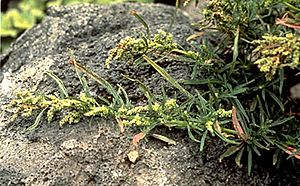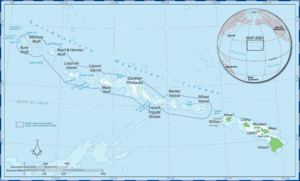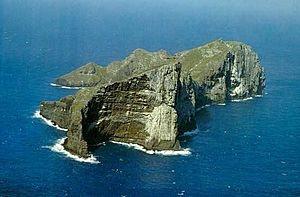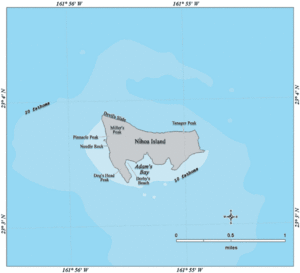Amaranthus brownii facts for kids
Quick facts for kids Amaranthus brownii |
|
|---|---|
 |
|
| Conservation status | |
| Scientific classification | |
| Genus: |
Amaranthus
|
| Species: |
brownii
|
Amaranthus brownii was a small plant that grew for only one year (an annual herb). It belonged to the Amaranthaceae family, which includes plants like spinach and quinoa. This special plant was found only on the tiny island of Nihoa in the Northwestern Hawaiian Islands. It grew on rocky areas between 120 and 215 meters (about 390 to 700 feet) above sea level.
A. brownii was one of nine types of Amaranthus plants in the Hawaiian Islands. What made it unique was that it was the only type of Amaranthus that grew nowhere else but Hawaii. Sadly, this plant is now considered extinct, meaning it has completely disappeared from Earth.
A botanist named Edward Leonard Caum first discovered A. brownii in 1923 during an adventure called the Tanager Expedition. This plant was different from other Hawaiian Amaranthus because its leaves didn't have thorns. Its leaves were also long and thin, and its fruits didn't open up to release seeds when they were ripe.
A. brownii was one of 26 different kinds of plants found on Nihoa. Out of these, 17 were native, six were brought by humans, and three were found only on Nihoa. These three unique plants were A. brownii, the Nihoa fan palm, and the Nihoa carnation. A. brownii was thought to be the rarest plant on Nihoa. No one has seen it on the island since 1983. Scientists tried to grow it from seeds and samples outside its natural home, but none of them survived. This means there are no known A. brownii plants or seeds left anywhere in the world.
The United States Fish and Wildlife Service (FWS) tried to protect A. brownii. They manage Nihoa island as part of the Hawaiian Islands National Wildlife Refuge. In 1996, the FWS officially listed the plant as an endangered species. By 2003, Nihoa island was named a "critical habitat" for the plant. The plant was also listed as critically endangered on the IUCN Red List. After more than 35 years of no sightings, even with many searches, the plant was officially declared extinct in 2018.
Contents
Discovering the Plant
The first Amaranthus brownii plant was found during the Tanager Expedition in 1923. Botanist Edward Leonard Caum collected the first sample on June 17, 1923. Another sample was collected a few days later by Charles S. Judd.
A botanist named Forest B. H. Brown helped describe some of the plants found on the expedition. Because of his help, Erling Christophersen and Caum named the plant A. brownii after him in 1931. They wrote about it in their paper, "Vascular plants of the Leeward Islands, Hawaii." In this paper, they said A. brownii was one of 20 different kinds of plants on Nihoa island. The FWS does not have a common name for this plant.
What it Looked Like
Amaranthus brownii was the only type of Amaranthus plant found only in the Hawaiian Islands. It was an annual plant, meaning it lived for only one year. It could grow to be about 30 to 90 centimeters (about 1 to 3 feet) tall.
The plant had narrow, thin leaves and small green flowers. Its fruit held a single, dark red seed. A. brownii was a monoecious plant. This means that both male and female flowers grew on the same plant.
It was different from other Hawaiian Amaranthus plants because its leaves did not have spines. Its fruits were oval-shaped and very small, about 0.8 to 1 millimeter long. Scientists believe the plant was pollinated by wind.
Where it Lived
Amaranthus brownii lived in a very small area. It was found only on the island of Nihoa, which is about 0.65 square kilometers (0.25 square miles) in size. Nihoa is located about 275 kilometers (170 miles) northwest of Kauai. Scientists think this unique plant was probably always rare and only grew on Nihoa.
Its home is now managed by the United States Fish and Wildlife Service. It is protected as part of the Hawaiian Islands National Wildlife Refuge. A. brownii was one of three special plants found only on Nihoa. The other two were the Nihoa fan palm (Pritchardia remota) and the Nihoa carnation (Schiedea verticillata).
Many other native plants also grew in its habitat. These included Hawaiian goosefoot (Chenopodium oahuense), lovegrass (Eragrostis variablis), koali ʻawa (Ipomoea indica), and ʻilima (Sida fallax).
The plant grew during the wet winter season, from December to July. It lived in Nihoa's dry shrubland habitat. It preferred shallow soil on rocky areas that were open to the sun. These areas were between 120 and 215 meters (about 390 to 700 feet) high.
When it was first discovered in 1923, scientists saw many A. brownii plants growing on the ridges near Miller Peak and on the eastern ridges of the island. Later trips in the 1960s didn't find any plants. But in 1969, Douglas E. Yen found some near Miller Peak. The last known sample was collected on July 27, 1980.
Scientists continued to visit Nihoa to look for the plant. In 1981 and 1983, Sheila Conant found A. brownii growing on the island. By 1983, only two groups of plants were thought to exist. There were 23 plants near Miller Peak and 12 plants in Middle Valley. These two groups were about 0.4 kilometers (0.25 miles) apart.
People living on Nihoa a long time ago might have caused the number of A. brownii plants to decrease. The biggest dangers to the plant were:
- Invasive species: Plants or animals that are not native and harm the environment.
- Fire: Wildfires could destroy their habitat.
- Hybridization: The plant mixing with other Amaranthus species, which could weaken its unique traits.
- Inbreeding: With such a small group of plants, they had to reproduce with each other. This can lead to genetic problems.
A. brownii also had to compete with a non-native weed called Portulaca oleracea. In 2002 and 2004, a large number of gray bird grasshoppers (Schistocerca nitens) became an even bigger threat. These grasshoppers were first seen on the island in 1977. Their growing numbers led to them eating almost all the plants on the island. In 2004, about 400,000 grasshoppers destroyed nearly 90% of Nihoa's plants. All these problems likely led to A. brownii's extinction.
Protecting the Plant
Zoologist Sheila Conant said that A. brownii was important because it was the only unique Hawaiian plant in its large group. This group includes many plants that are important for food and other uses. However, after more than ten years of searching on Nihoa, no living A. brownii plants were found.
Wildlife staff visited the island many times between 1983 and 1996. At first, scientists thought they might not be finding the plant because they visited during the dry summer months. During this time, the stems of A. brownii would dry up and be hard to tell apart from other plants. But even a visit in April 2006, and other winter searches, did not find any specimens.
Efforts to grow A. brownii from seeds in botanical gardens also failed. In 1981, Sheila Conant collected seeds and sent them to the Waimea Arboretum in Hawaii and Kew Gardens in London, England. The seeds at Waimea Arboretum sprouted and grew for a while, but none of the plants survived past the seedling stage. We don't have information about what happened to the seeds sent to Kew Gardens.
A plan to list A. brownii under the U.S. Endangered Species Act was first suggested in 1976. It was later withdrawn and then suggested again in 1993. On August 21, 1996, it was officially listed as an endangered species.
On May 22, 2003, the FWS named 171 acres (about 69 hectares) on Nihoa island as "critical habitat" for A. brownii. This area was also important for the Nihoa fan palm (Pritchardia remota), the Nihoa carnation (Schiedea verticillata), and two other Hawaiian plants. Also in 2003, A. brownii was listed as critically endangered on the IUCN Red List. By 2010, A. brownii was one of 51 Hawaiian plant species listed as endangered or threatened.
See also
 In Spanish: Amaranthus brownii para niños
In Spanish: Amaranthus brownii para niños
Images for kids






